Discover the transformative role of AI publishing and learn how publishers can harness the power of AI-driven content writing to enhance their creative processes and stay ahead in the digital age.
The publishing industry is changing significantly, all thanks to the meteoric rise of automation and artificial intelligence (AI).
AI is used for the automation of tasks, improvement in efficiency, and creation of new and innovative publishing methods.
Today, AI can be used in publishing in various ways, including content creation to generate content, such as articles, blog posts, and social media posts, edit content for grammar, spelling, and clarity, and personalize content for each reader.
But is it right to do so? What benefits can be reaped from AI publishing? And what about the limitations that will come up?
Let’s find out the answers to all these questions and a guide on how publishers can leverage AI content writing to improve their businesses.
AI Publishing: How Would That Pan Out?
Artificial intelligence is emerging as an unstoppable force. In the context of publishing, AI refers to the use of advanced technologies to replicate human-like functions such as problem-solving and learning.
This technological leap is enhancing efficiency and revolutionizing the way content creation, distribution, and consumption are done.
Applications of AI in the Publishing Industry
AI’s applications in the publishing industry are diverse and impactful, extending far beyond automation.
This technology can reshape how publishers approach content creation, optimization, and audience engagement.
Natural Language Processing (NLP)
At the heart of AI’s influence on publishing lies NLP or natural language processing that enables machines to generate, understand, and interpret human language.
NLP algorithms are meant to extract meaning from text, enabling publishers to analyze vast amounts of content swiftly.
Publishers can leverage NLP-powered tools to automate tasks such as summarizing articles, identifying keywords, and categorizing content.
That saves time and enables publishers to allocate resources more effectively, focusing on higher-value tasks that require human creativity and expertise.
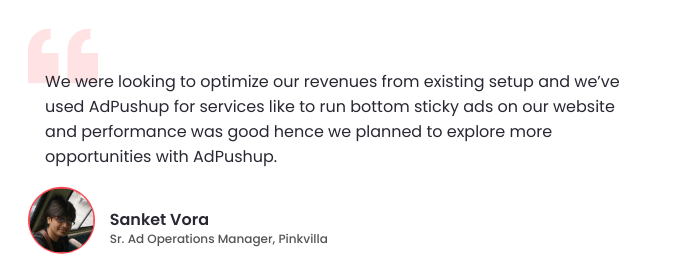
Machine Learning (ML)
Another branch of AI, machine learning, revolutionizes the creative process by letting computers learn from data and gradually enhance their performance without the need for human intervention.
Machine learning algorithms may be trained on massive datasets in the publishing industry to identify patterns, forecast trends, and provide readers with tailored content suggestions.
Machine learning fueled by artificial intelligence may do wonders for the publishing industry. Publishers may increase reader engagement and foster deeper relationships with their audience by using data to create content specifically for each reader.
This personalization improves the user experience and helps publishers deliver content that resonates with their readership.
Keyword Integration
Throughout this process of understanding AI publishing, it’s important to note that AI tools for publishers are becoming increasingly relevant.
The integration of AI tools, such as those designed for content analysis and optimization, allows publishers to tap into the power of AI in content creation.
Adopting AI publishing strategies can help publishers streamline their processes, deliver higher-quality content, and ultimately enhance their competitive edge in the industry.
Benefits of Leveraging AI Publishing
There’s a growing recognition of how AI-powered tools can revolutionize content creation.
Publishers are discovering several key benefits that come with embracing AI in their content writing processes:
Improved Efficiency
The integration of AI publishing brings forth a significant enhancement in efficiency. AI-powered tools with advanced algorithms can rapidly generate content across various formats, saving publishers valuable time and resources.
Using AI, publishers may speed up the process of writing content such as articles, blogs, and even product descriptions.
It helps publishers produce material faster, so they can fulfill deadlines and react to trends and breaking news more rapidly.
Enhanced Consistency
Maintaining a consistent tone, style, and quality across a large content volume can be challenging for publishers.
However, AI publishing offers a solution to this issue. Configuring AI tools with specific guidelines and parameters can help publishers ensure that their content maintains a uniform voice and style.
Whether adhering to brand guidelines or a particular writing style, AI helps maintain a cohesive and professional content output.
Time Savings
One of the most tangible benefits of leveraging AI in content writing is the significant time savings it affords publishers.
Automating routine content creation tasks can allow publishers to redirect their creative energy and focus toward more strategic endeavors.
This strategic shift allows publishers to produce higher-quality content that resonates with their target audience.
Limitations of Leveraging AI Publishing
While the integration of AI publishing holds immense promise, it’s essential to acknowledge that there are limitations to its application.
Publishers looking to leverage AI in content creation strategies should know these challenges.
Lack of Creativity and Nuance
AI tools excel at data processing and pattern recognition, but they often struggle to replicate the nuanced creativity that human writers bring to their work.
The distinct voice, emotional depth, and creative flair that human authors infuse into their content can be challenging for AI algorithms to replicate accurately.
Content Originality and Plagiarism
AI-generated content might inadvertently produce text that resembles existing content online, raising concerns about originality and potential plagiarism.
Careful review and editing are necessary to ensure that AI-generated content is unique and not infringing upon copyright.
Contextual Understanding
Although AI may create language based on patterns, it may need knowledge of the topic’s context or complexities in order to provide accurate results.
This may cause information that is inaccurate, misleading, or inconsistent with the original message to be spread.
Tone Inconsistencies
It is crucial for publishers to keep the tone and style of their publications uniform.
Artificially produced material may need assistance in maintaining a uniform tone, style, or voice across an article or series.
Ethical and Bias Concerns
AI tools can inadvertently introduce bias in their training data into the content they generate.
Additionally, ethical questions arise when using AI to create content that mimics human writing, as it might deceive readers into thinking a human author produced it.
How to Leverage AI for Content Writing?
Assess Your Content Creation Needs
Before diving into AI-powered content writing, take the time to evaluate your content creation requirements. Identify the types of content you produce, the volume needed, and the challenges you face.
Consider where AI can benefit most, such as automating repetitive tasks or generating data-driven insights.
Explore AI Content Generation Platforms
Learn about the different AI content production tools out there by doing some digging. Locate resources that cater to your specific needs.
Establish Clear Guidelines for the AI Tools
Establish clear guidelines for the AI tool to follow to ensure that AI-generated content aligns with your brand voice and style.
Set guidelines, such as the desired voice, style, terminology, and layout.
Add Human Oversight to Filter AI Content
While AI may help speed up the content generation process, human review is still necessary to ensure high quality.
Check the AI-generated material for correctness, consistency, and applicability. Adjust the text as needed so that it reflects your vision as an editor and connects with your target audience.
Emphasize the Iterative Process of Refining AI Models
Keep in mind that developing AI-written content is a never-ending task. To improve the AI models, collect comments from readers and editorial staff.
Keep an eye on how well the AI-created material is doing, and tweak it depending on feedback.
Content Originality and Plagiarism
There could be instances where the AI-generated content you see is scrapped from elsewhere or pretty similar to the existing online sources. Hence, publishing such content without paying attention to originality and plagiarism may lead to serious problems.
You can’t easily figure out duplication yourself. The free plagiarism checker you find online could be a handy tool to identify plagiarism in AI-generated content. Once you are aware of plagiarized sections in AI-generated content, you can easily modify them and eradicate duplication yourself.
Looking at the Best Tools for AI Tools For Publishers for Writing Content
Rytr
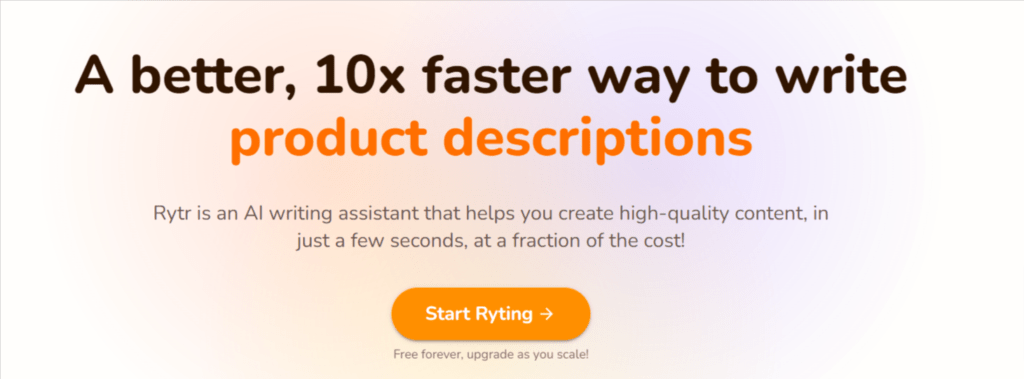
Rytr is an AI writing tool with a significant presence among others in its league. It’s an all-around AI helper that suits different types of marketers.
It offers templates for various writing tasks like blogs and product descriptions. Once you try it, your writing style might change for good.
Key Features of Rytr
- AI content in 30+ languages
- User-friendly interface, long-form editor, dark mode
- 40+ templates for quick ideas
- Chrome extension for seamless AI in apps
Pricing
- Free Plan
- Saver Plan at $9/month
- Unlimited Plan at $29/month
Jasper
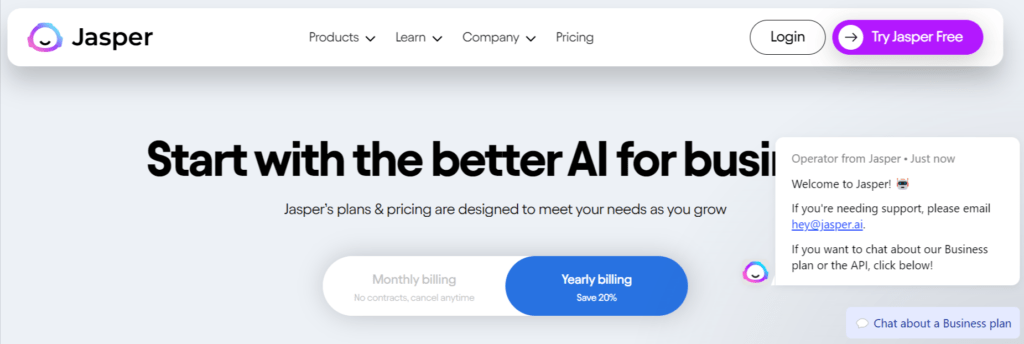
Jasper is a viral AI writing platform. It offers robust AI tools for creating content like long articles, SEO content, blogs, sales emails, and more.
They also provide training, courses, and conferences centered around their features, which are popular among AI users.
Key Features of Jasper
- Integrates with Chrome extension, Surfer SEO, Grammarly
- Excellent documentation, support, and training by the company
- AI art included in all plans
- Can write about today’s news using internet access
- Boss Mode
Pricing
- Creator Plan at $39/month
- Teams Plan at $99/month
- Business Plan after talking with the sales team
Copy.ai
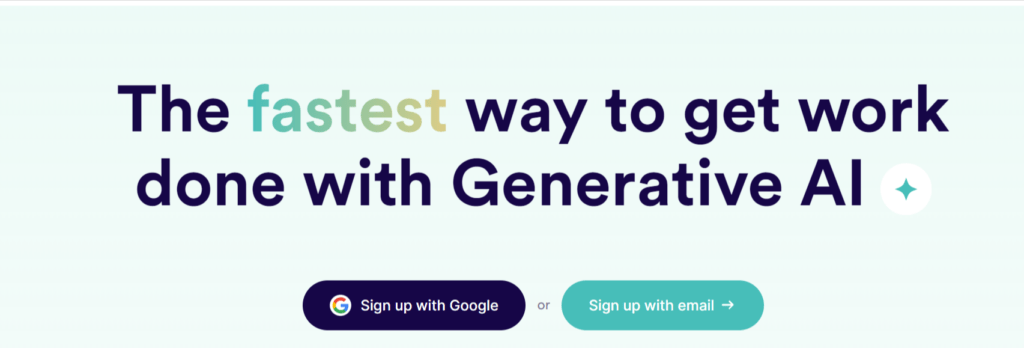
Another AI publishing tool in the list is Copy.ai, which is a widely used AI tool designed for creating AI-generated content like blogs, social media posts, and email copy.
It comes with intelligent features and tools ideal for sales and marketing teams. It can significantly boost your productivity by using AI for specific tasks.
Key Features of Copy.ai
- API links with LinkedIn, CRMs, and marketing tools
- Pricing depends on AI generations, not just word count
- Chat by Copy.ai offers a ChatGPT-like interface
Pricing
- Free Plan
- Pro Plan at $49/month
- Enterprise Plan after talking with the sales team
Writesonic
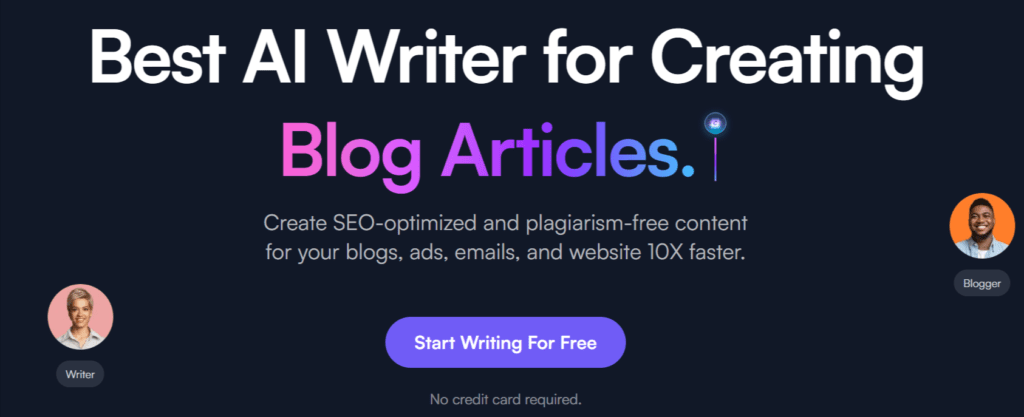
Writesonic stands out as an AI writing tool that offers some cool stuff in one place. The free Plan allows AI content generation of around 10,000 words on their supercharged GPT 3.5 platform.
If you’re willing to pay, their higher-tier plans get a boost from GPT 4.
Key Features of Writesonic
- AI copywriting tools with 100+ templates for blogs and more
- Landing page copy generator that includes static landing page coding
- Collaborative editor for team collaboration
- Integrates with Zapier and Surfer SEO
Pricing
- Free Trial at 10,000 words/month
- Business Plan at $12.67/month
- Unlimited Plan at $16/month
- Enterprise Plan after talking with the sales team
Final Thoughts on AI Publishing
AI publishing isn’t just a fleeting trend; it’s a transformative force that empowers publishers to streamline their workflows and enhance content quality.
Publishers can tap into various tools tailored to their needs by using AI. The journey begins with identifying the right AI tools that resonate with your publishing objectives.
Platforms with AI capabilities have become instrumental in simplifying complex processes, ultimately saving valuable time and resources.
Remember, as AI tools assist in content creation, they still need to replace the role of human insight and creativity.
Human editors and writers are still necessary to fine-tune AI-generated content so that it reflects your brand’s voice and connects with your target demographic.
Looking ahead, the synergy of AI and publishing promises exciting developments. From improved predictive analytics to hyper-personalized content delivery, AI’s influence will only deepen.
Publishers are willing to embrace these changes, adapt to the shifting paradigms, and are poised to lead the charge toward a more efficient and engaging content future.
Frequently Asked Questions
The future of AI publishing holds increased automation in content creation, improved personalization, and data-driven insights for better audience engagement.
AI will impact publishing by streamlining content creation, enhancing content quality, enabling personalized experiences, and providing valuable insights into audience preferences.
To create AI content, explore AI writing tools like Writesonic. Input your requirements, prompts, or keywords; the AI generates content you can edit and customize for your needs.

Nidhi Mahajan is a content author with a remarkable talent for ad tech. With a deep understanding of the ad tech industry and a sharp focus on detail, she excels in crafting insightful articles and compelling narratives. Nidhi is dedicated to making the complexities of ad tech more accessible to all through her clear and informative writing.







